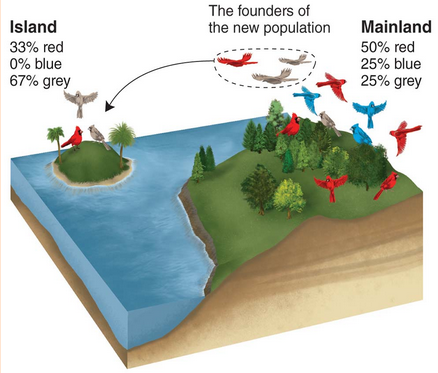2.6: Adaptations
1/22
There's no tags or description
Looks like no tags are added yet.
Name | Mastery | Learn | Test | Matching | Spaced |
|---|
No study sessions yet.
23 Terms
Evolution
A change in the genetic composition of a population over time.
Gene
A physical location on the chromosomes within each cell of an organism.
Genotype
The complete set of genes in an individual.
Phenotype
A set of traits expressed by an individual.
Fitness
An individual’s ability to survive and reproduce.
Adaptation
A trait that improves an individual’s fitness.
Natural Selection
mechanism by which individuals that have inherited beneficial adaptations produce more offspring on average than do other individuals.
Nature is the selective agent
Characteristics are selected only if they give advantages to individuals
Takes many generations
Selection pressures
external agents which affect an organism’s ability to survive in a given environment
can be negative (decreases the occurrence of a trait) or positive (increases the proportion of a trait)
may not remain constant, leading to changes in what constitutes a beneficial adaptation
Types of selection pressures
Resource availability – Presence of sufficient food, habitat (shelter / territory) and mates
Environmental conditions – Temperature, weather conditions or geographical access
Biological factors – Predators and pathogens (diseases)
Sexual dimorphism
The differences in appearance between males and females of the same species, such as in colour, shape, size, etc.
Reproductive pressures act on the males of the species making them brighter and flashier BUT AT A COST!
Predation pressures act on the females.

Adaptation
an inherited characteristic that favors the survival or reproduction of an organism, and is the result of natural selection.
Can be:
Behavioral: Migration, hibernation
Physiological: temperature regulation (camel hump with water), release of toxins/poisons (snake venom)
Structural: body color (camouflage, seasonal change, warning vs disruptive coloration, deceptive markings), body covering, beak type, and claw type.
Batesian Mimicry
A harmless animal (the mimic) copies a known harmful animal (the model)
Ex. The venomous coral snake serves as a model for the harmless king snake.
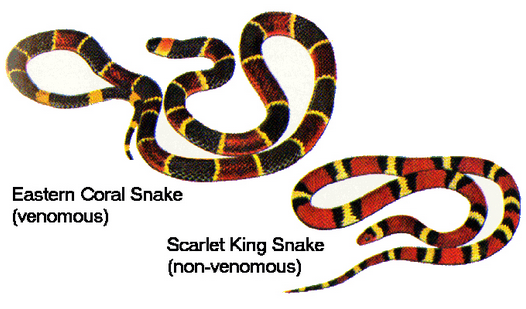
Mullerian Mimicry
Both model and mimic are equally harmful to predators
Advantage:
A single taste trial by a predator will secure future protection for two or more species
Ex. The Monarch and the Viceroy
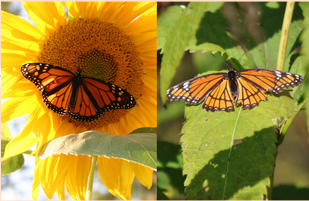
Fitness
an organism’s ability to survive and reproduce in its specific environment
Survival of the Fittest
those who have the most pertinent adaptations survive to reproduce, those less suited to the environment die without passing on their traits
over time (many generations) natural selection results in changes in the inherited characteristics of a POPULATION thus increasing a species “fitness” in its environment
Microscale vs Macroscale
Microscale
Mutation
Recombination
Macroscale
Gene flow
Genetic drift
Bottleneck effects
Founder effects
Mutation
A random change in the genetic code produced by a mistake in the copying process.
Recombination
The genetic process by which one chromosome breaks off and attaches to another chromosome during reproductive cell division.
Gene flow
The process by which individuals move from one population to another and thereby alter the genetic composition of both populations.
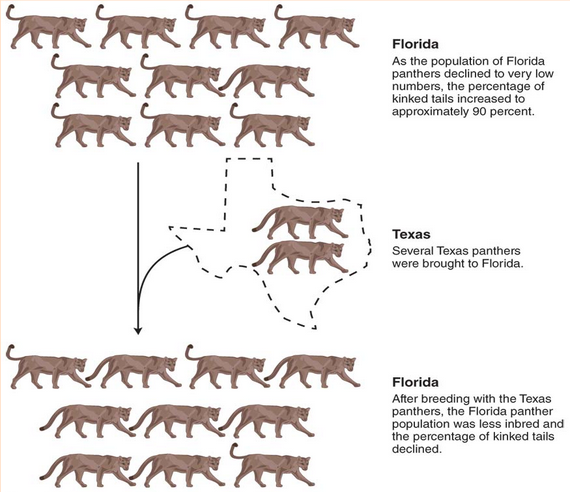
Genetic drift
A change in the genetic composition of a population over time as a result of random mating.
In a small population, some less-common genotypes can be lost
In a large population, it is more difficult for the less-common genotypes to be lost
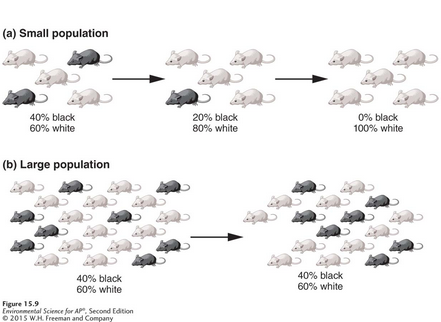
Bottleneck effect
an extreme example of genetic drift that happens when the size of a population is severely reduced.
Events like natural disasters (earthquakes, floods, fires) can decimate a population, killing most individuals and leaving behind a small, random assortment of survivors.
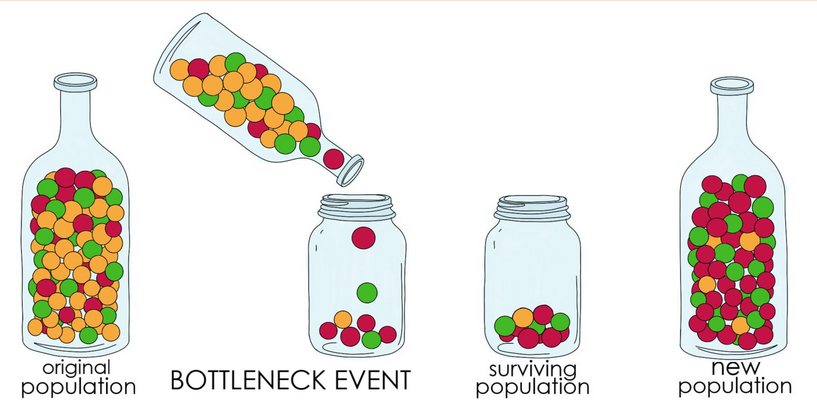
Extinction
The death of the last member of a species.
Reduced population numbers means reduced genetic variation and a decreased ability to adapt to future changes
Founder effect
A change in the genetic composition of a population as a result of descending from a small number of colonizing individuals.
The genotypes on the island will represent only a subset of the genotypes present in the mainland population.
